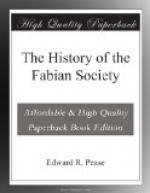The University Fabian Societies are of a different character. Formed by and for undergraduates, but in some cases, especially at Oxford, maintaining continuity by the assistance of older members in permanent residence, such as Sidney Ball of St. John’s, who has belonged to the Oxford Society since its formation in 1895, they are necessarily fluctuating bodies, dependent for their success on the personality and influence of a few leading members. Their members have always been elected at once to the parent society in order that the connection may be unbroken when they leave the University. Needless to say, only a small proportion become active members of the Society, but a few of the leading members of the movement have entered it in this way. Oxford, Glasgow, Aberystwyth, and latterly Cambridge have had flourishing societies for long periods, and quite a number of the higher grade civil servants and of the clergy and doctors in remote districts in Wales and Scotland are or have been members. Moreover, the Society always retains a scattering of members, mostly officials or teachers, in India, in the heart of Africa, in China, and South America, who joined it in their undergraduate days.
Almost from the first the Executive has endeavoured to organise the members in the London area into groups. The parent society grew up through years of drawing-room meetings; why should not the members residing in Hampstead and Hammersmith, in Bloomsbury or Kensington do the same? Further, the Society always laid much stress on local politics: there were County Council and Borough Council, School Board and Poor Law Guardians elections in which policy could be influenced and candidates promoted or supported.
In fact it is only in the years when London government was in the melting-pot, or in times of special socialist activity, and in a few districts, such as Hampstead, where Fabians are numerous, and especially when one or more persons of persistence and energy are available, that the groups have had a more than nominal existence. The drawing-room meetings of the parent society attracted audiences until they outgrew drawing-rooms, because of the exceptional quality of the men and women who attended them and the novelty of the doctrines promulgated. These conditions were not repeated in each district of London, and in spite of constant paper planning, and not a little service by the older members, who spent their time and talents on tiny meetings in Paddington or Streatham, the London group system has never been a permanent success. What has kept the Society together is the series of fortnightly meetings carried on regularly from the first, which themselves fluctuate in popularity, but which have never wholly failed.[26]




